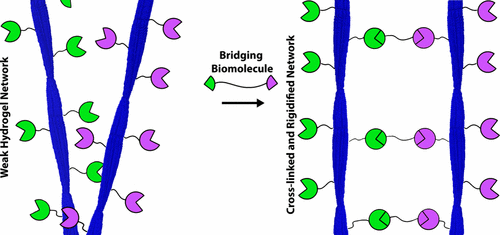当前位置:
X-MOL 学术
›
Biomacromolecules
›
论文详情
Our official English website, www.x-mol.net, welcomes your
feedback! (Note: you will need to create a separate account there.)
Modulating Supramolecular Peptide Hydrogel Viscoelasticity Using Biomolecular Recognition
Biomacromolecules ( IF 5.5 ) Pub Date : 2017-09-14 00:00:00 , DOI: 10.1021/acs.biomac.7b00925 John T. M. DiMaio 1 , Todd M. Doran 1 , Derek M. Ryan 1 , Danielle M. Raymond 1 , Bradley L. Nilsson 1
Biomacromolecules ( IF 5.5 ) Pub Date : 2017-09-14 00:00:00 , DOI: 10.1021/acs.biomac.7b00925 John T. M. DiMaio 1 , Todd M. Doran 1 , Derek M. Ryan 1 , Danielle M. Raymond 1 , Bradley L. Nilsson 1
Affiliation

|
Self-assembled peptide-based hydrogels are emerging materials that have been exploited for wound healing, drug delivery, tissue engineering, and other applications. In comparison to synthetic polymer hydrogels, supramolecular peptide-based gels have advantages in biocompatibility, biodegradability, and ease of synthesis and modification. Modification of the emergent viscoelasticity of peptide hydrogels in a stimulus responsive fashion is a longstanding goal in the development of next-generation materials. In an effort to selectively modulate hydrogel viscoelasticity, we report herein a method to enhance the elasticity of β-sheet peptide hydrogels using specific molecular recognition events between functionalized hydrogel fibrils and biomolecules. Two distinct biomolecular recognition strategies are demonstrated: oligonucleotide Watson–Crick duplex formation between peptide nucleic acid (PNA) modified fibrils with a bridging oligonucleotide and protein–ligand recognition between mannose modified fibrils with concanavalin A. These methods to modulate hydrogel elasticity should be broadly adaptable in the context of these materials to a wide variety of molecular recognition partners.
中文翻译:

使用生物分子识别调节超分子肽水凝胶粘弹性
自组装的基于肽的水凝胶是新兴材料,已被用于伤口愈合,药物输送,组织工程和其他应用。与合成聚合物水凝胶相比,基于超分子肽的凝胶在生物相容性,生物降解性以及易于合成和修饰方面具有优势。以刺激响应方式修饰肽水凝胶的新兴粘弹性是下一代材料开发中的长期目标。为了选择性地调节水凝胶的粘弹性,我们在此报告了一种利用功能化水凝胶原纤维和生物分子之间的特定分子识别事件来增强β-sheet肽水凝胶的弹性的方法。展示了两种不同的生物分子识别策略:
更新日期:2017-09-15
中文翻译:

使用生物分子识别调节超分子肽水凝胶粘弹性
自组装的基于肽的水凝胶是新兴材料,已被用于伤口愈合,药物输送,组织工程和其他应用。与合成聚合物水凝胶相比,基于超分子肽的凝胶在生物相容性,生物降解性以及易于合成和修饰方面具有优势。以刺激响应方式修饰肽水凝胶的新兴粘弹性是下一代材料开发中的长期目标。为了选择性地调节水凝胶的粘弹性,我们在此报告了一种利用功能化水凝胶原纤维和生物分子之间的特定分子识别事件来增强β-sheet肽水凝胶的弹性的方法。展示了两种不同的生物分子识别策略:











































 京公网安备 11010802027423号
京公网安备 11010802027423号